Coverage Analysis for High-Speed Railway Communications with Narrow-Strip-Shaped Cells over Suzuki Fading Channels
Abstract
:1. Introduction
- We analyze the coverage performance at the cell edge. First, we analyze the statistical characteristics of the received signal-to-noise ratio (SNR). Then, according to the definition of ECP and the Gaussian–Hermite integral, we derive an analytical expression of the ECP. The ECP expression is shown to be a function of transmit power, cell radius, noise variance, standard deviation of shadow fading, HSR propagation environment, and SNR threshold.
- We analyze the average coverage performance of a cell, which can be characterized by the percentage of CCA. According to its mathematical definition, we derive its analytical expression. The percentage of CCA is also expressed as a function of system key parameters.
- We obtain a theoretical expression to link the ECP and the percentage of CCA. The percentage of CCA is expressed as the summation of the ECP and a positive increment. Thus, the relationship between the ECP and the percentage of CCA is established. As special cases, we also derive the theoretical expressions for the system without considering the small-scale fading.
- Some numerical results are provided. It is shown that the theoretical results match well with the simulation results, which verifies the accuracy of the derived theoretical expressions. Moreover, the small-scale fading has a strong effect on coverage performance, and thus it cannot be ignored. Furthermore, the effects of cell radius, transmit power, SNR threshold, propagation environment, and the shadow fading standard derivation on coverage performance are also provided.
2. System Model
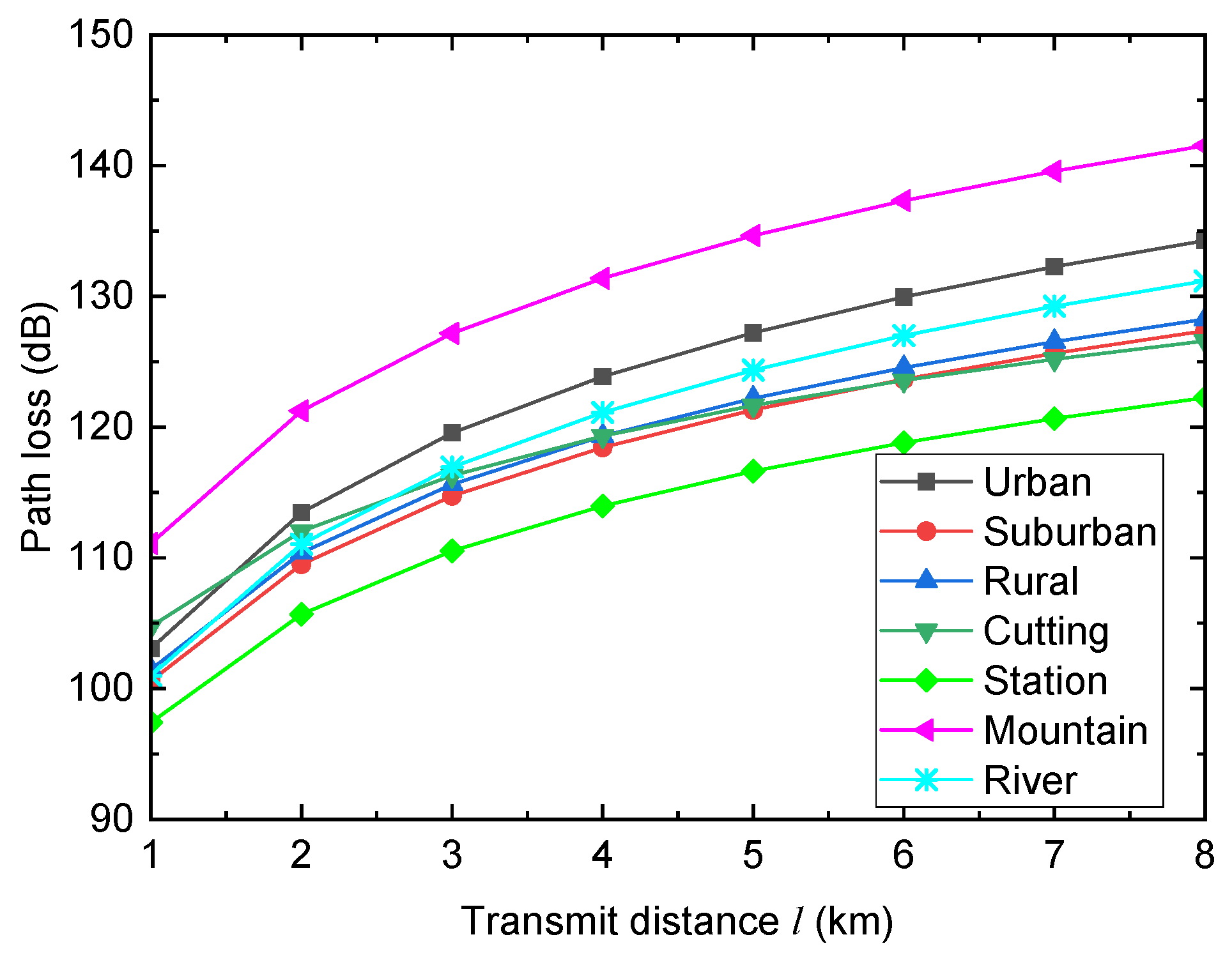
3. Coverage Performance Analysis
3.1. Statistical Characteristics of SNR
3.2. ECP Analysis
3.3. Percentage of CCA Analysis
4. Relationship between ECP and Percentage of CCA
5. Numerical Results
5.1. Results of ECP


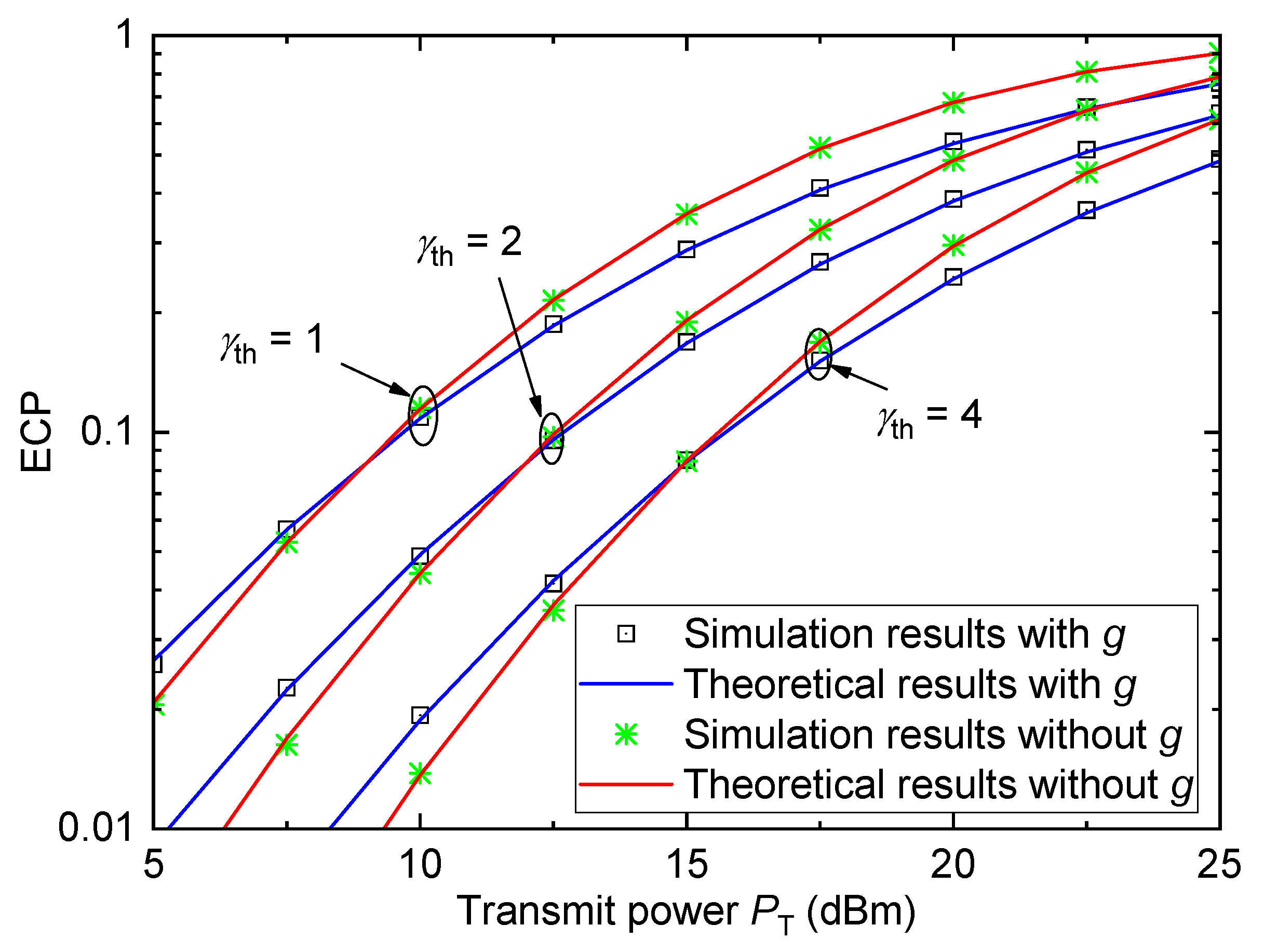
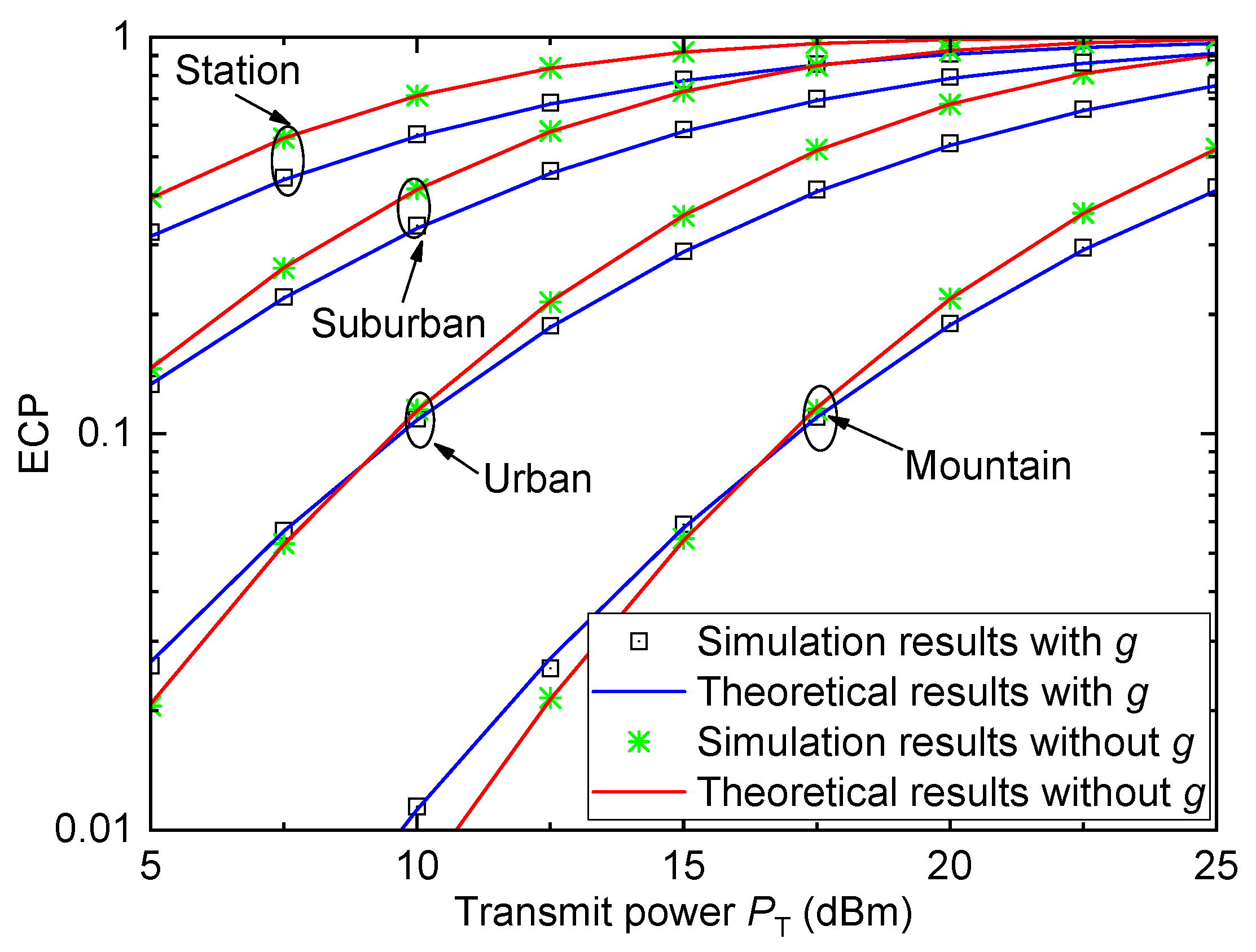
5.2. Results of Percentage of CCA

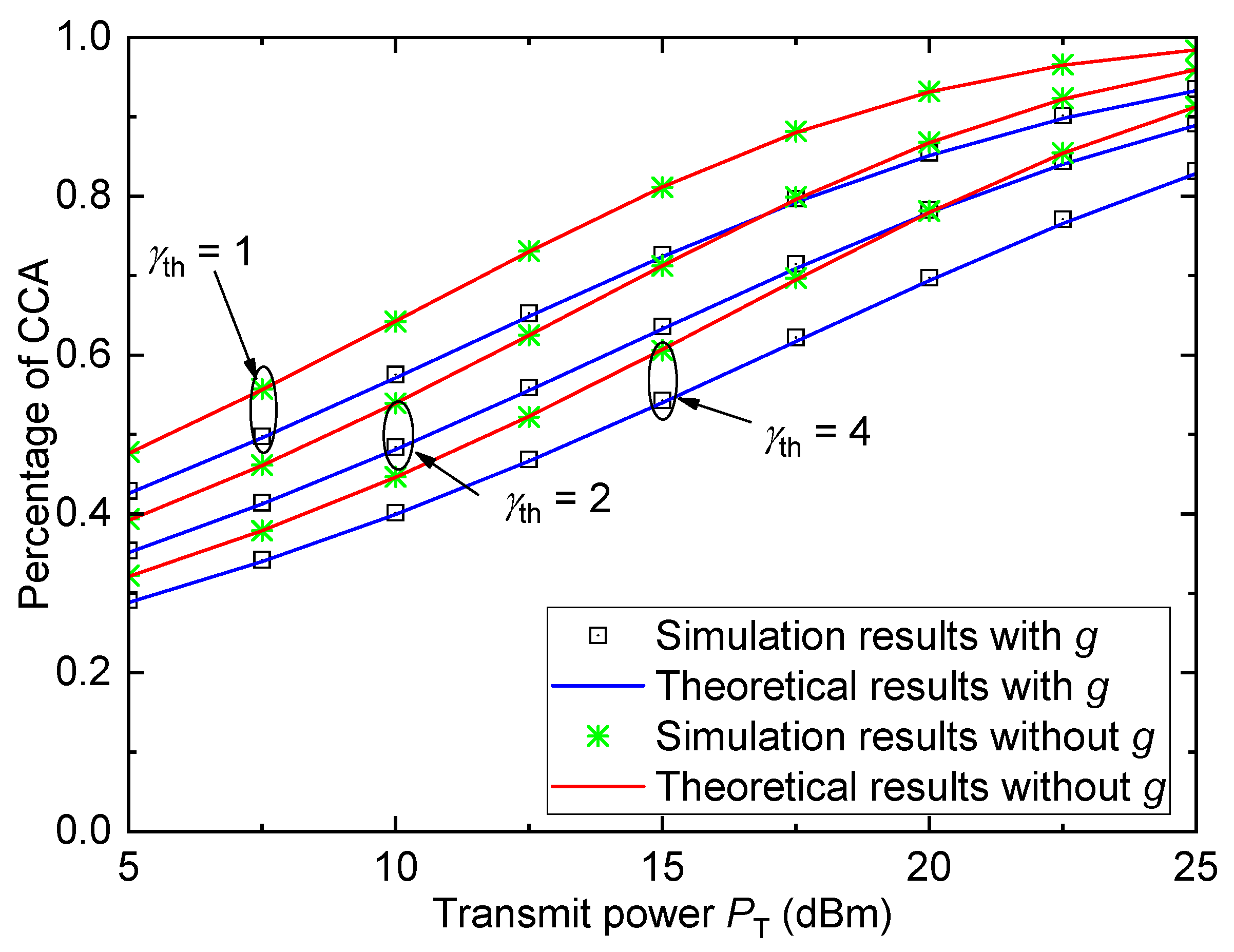
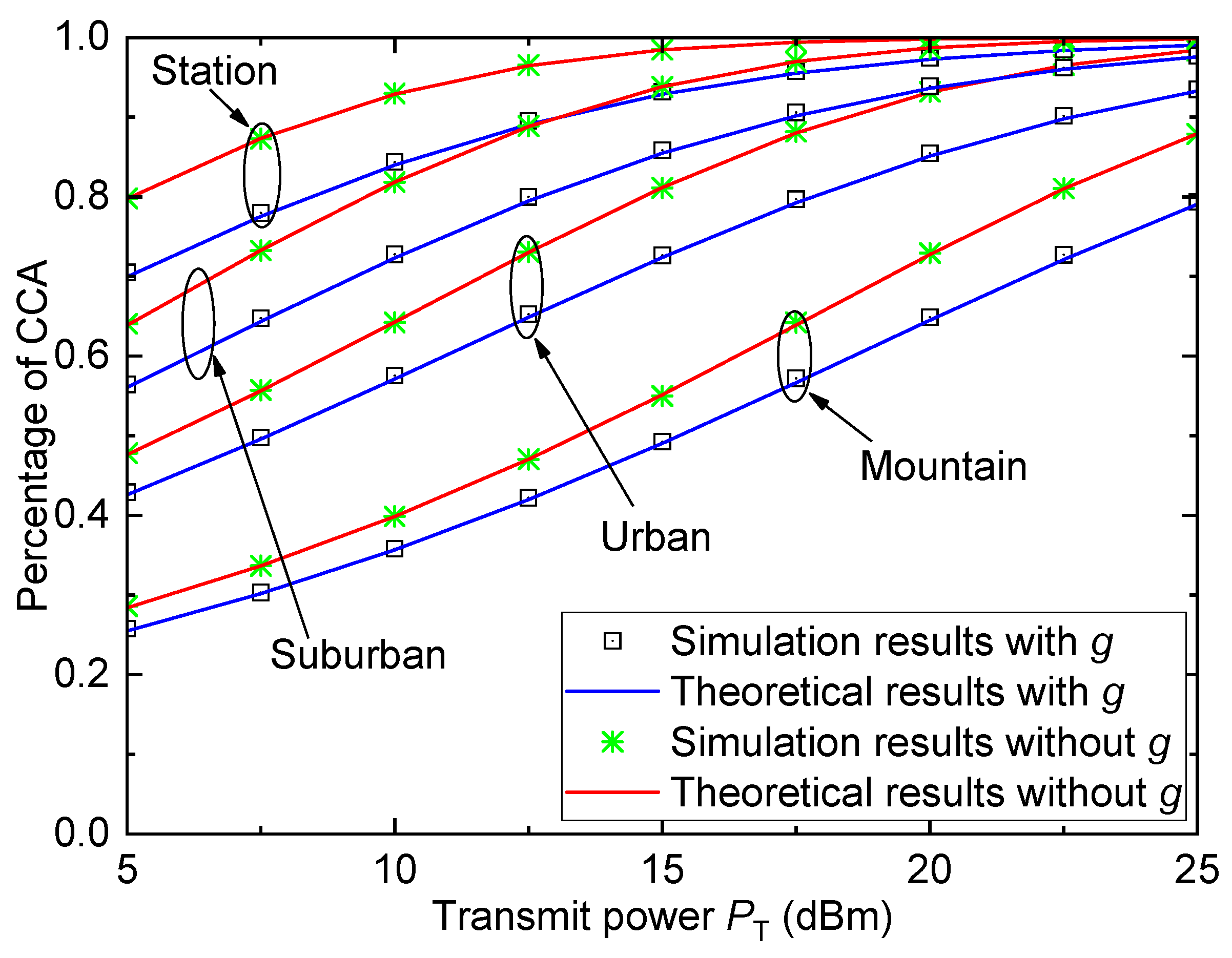
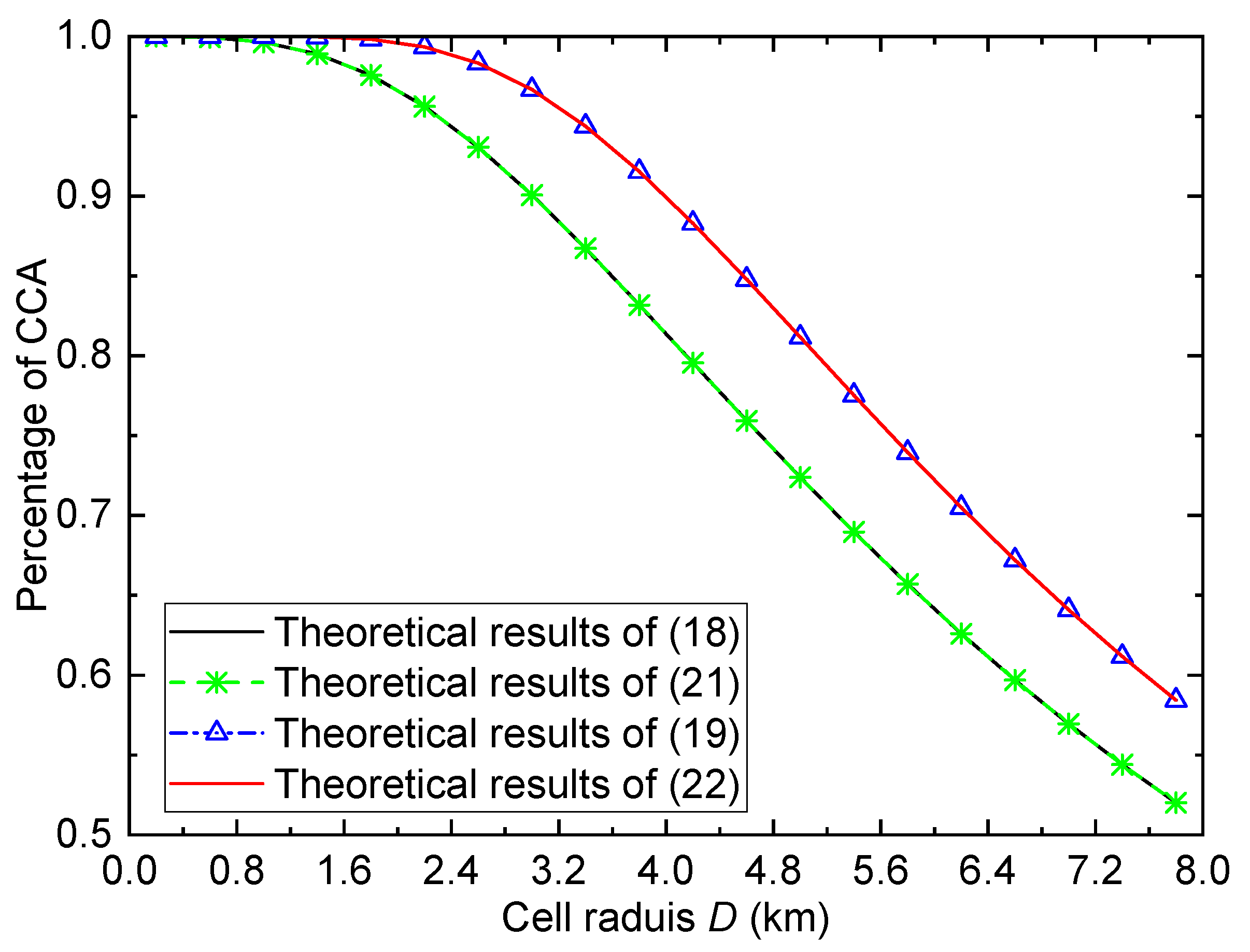
6. Conclusions
- For the HSR system with small-scale fading, analytical expressions of the ECP and the percentage of CCA are derived, respectively. To facilitate the comparison, the coverage performance indicator expressions for the system without considering the small-scale fading are also derived. Numerical results verify the accuracy of the derived expressions.
- To link the edge coverage performance and the average coverage performance of the whole cell, we derive the relationship between the ECP and the percentage of CCA. Specifically, the percentage of CCA is expressed as the summation of the ECP and a positive increment. Therefore, the average coverage performance of a cell is always better than the edge coverage performance.
- The HSR propagation environments have strong effects on coverage performance. For example, the station scenario has a smaller path loss and thus has a better coverage performance, while the mountain scenario has a larger path loss and thus has a worse coverage performance.
- It is shown that the ECP or the percentage of CCA will be overestimated or underestimated if the small-scale fading is not considered. This indicates that, for the coverage analysis in HSR communications, the small-scale fading cannot be ignored.
- The cell radius, transmit power, SNR threshold, and shadow fading standard derivation also have strong effects on coverage performance. Specifically, the coverage performance improves with the decrease in cell radius, the increase in transmit power, the decrease in SNR threshold, or the decrease in shadow fading standard derivation.
Author Contributions
Funding
Institutional Review Board Statement
Data Availability Statement
Acknowledgments
Conflicts of Interest
Appendix A. Proof of Theorem 1
Appendix B. Proof of Theorem 2
Appendix C. Proof of Corollary 2
Appendix D. Proof of Theorem 3
Appendix E. Proof of Corollary 3
References
- Li, P.; Zhu, Y.; Liu, Y.; Jin, C. Research on system architecture, basic platform, and development path of autonomous intelligent high-speed railway systems. IEEE Intell. Transport. Syst. Mag. 2024, 16, 62–73. [Google Scholar] [CrossRef]
- Goldsmith, A. Wireless Communications; Cambridge University Press: Cambridge, UK, 2005. [Google Scholar]
- Borralho, R.; Quddus, A.U.; Mohamed, A.; Vieira, P.; Tafazolli, R. Coverage and data rate analysis for a novel cell-sweeping-based RAN deployment. IEEE Trans. Wireles Commun. 2024, 23, 217–230. [Google Scholar] [CrossRef]
- Reudink, D.O. Properties of mobile radio propagation above 400 MHz. IEEE Trans. Veh. Technol. 1974, VT-23, 143–159. [Google Scholar] [CrossRef]
- Homnan, B. On the cell coverage area of overlap area-based cellular model in wireless cellular systems: Base station locations. In Proceedings of the International Conference on Future Networks, Bangkok, Thailand, 7–9 March 2009; pp. 113–116. [Google Scholar]
- Yang, H. Simple formulas for area coverage probability of cellular wireless networks. In Proceedings of the 2012 IEEE 75th Vehicular Technology Conference, Yokohama, Japan, 6–9 May 2012; pp. 1–5. [Google Scholar]
- Zhang, J.-Y.; Tan, Z.-H.; Yu, Z.-Z. Coverage efficiency of radio-over-fiber network for high-speed railways. In Proceedings of the 6th International Conference on Wireless Communications, Networking and Mobile Computing, Chengdu, China, 23–25 September 2010; pp. 1–4. [Google Scholar]
- Gui, L.; Ma, W.; Liu, B.; Shen, P. Single frequency network system coverage and trial testing of high speed railway television system. IEEE Trans. Broadcast. 2010, 56, 160–170. [Google Scholar]
- Gómez, J.M.N.; Castanho, R.A.; Fernández, J.C.; Loures, L.C. Assessment of high-speed rail service coverage in municipalities of peninsular Spain. Infrastructures 2020, 5, 11. [Google Scholar] [CrossRef]
- Munjal, M.; Singh, N.P. Low cost communication for high speed railway. Wireless Pers. Commun. 2020, 111, 163–178. [Google Scholar] [CrossRef]
- Munjal, M.; Singh, N.P. Group mobility by cooperative communication for high speed railway. Wireless Netw. 2019, 25, 3857–3866. [Google Scholar] [CrossRef]
- Ai, B.; He, R.; Li, G.; Guan, K.; He, D.; Zhing, Z. Determination of cell coverage area and its applications in high-speed railway environments. IEEE Trans. Veh. Technol. 2017, 66, 3515–3525. [Google Scholar] [CrossRef]
- Liu, X.; Qiao, D. Design and coverage analysis of elliptical cell based beamforming for HSR communication systems. In Proceedings of the IEEE International Conference on Communications, Shanghai, China, 20–24 May 2019; pp. 1–6. [Google Scholar]
- Taheri, M.; Ansari, N.; Feng, J.; Rojas-Cessa, R.; Zhou, M. Provisioning internet access using FSO in high-speed rail networks. IEEE Netw. 2017, 31, 96–101. [Google Scholar] [CrossRef]
- Fan, Q.; Taheri, M.; Ansari, N.; Feng, J.; Rojas-Cessa, R.; Zhou, M.; Zhang, T. Reducing the impact of handovers in ground-to-train free space optical communications. IEEE Trans. Veh. Technol. 2018, 67, 1292–1301. [Google Scholar] [CrossRef]
- Lin, S.-H.; Zu, Y.; Wang, J.-Y. Coverage analysis and optimization for high-speed railway communication systems with narrow-strip-shaped cells. IEEE Trans. Veh. Technol. 2020, 69, 11544–11556. [Google Scholar] [CrossRef]
- Lin, S.-H.; Xu, Y.; Wang, L.; Wang, J.-Y. Coverage analysis and chance-constrained optimization for HSR communications with carrier aggregation. IEEE Trans. Intell. Transp. Syst. 2022, 23, 15107–15120. [Google Scholar] [CrossRef]
- Lin, S.-H.; Xu, Y.; Wang, J.-Y. Coverage analysis for cell-free massive MIMO high-speed railway communication systems. IEEE Trans. Veh. Technol. 2022, 71, 10499–10511. [Google Scholar] [CrossRef]
- He, R.; Zhing, Z.; Ai, B.; Guan, K. Reducing the cost of high-speed railway communications: From the propagation channel view. IEEE Trans. Intell. Transp. Syst. 2015, 16, 2050–2060. [Google Scholar] [CrossRef]
- Liu, L.; Tao, C.; Qiu, J.; Chen, H.; Yu, L.; Dong, W.; Yuan, Y. Position-based modeling for wireless channel on high-speed railway under a viaduct at 2.35 GHz. IEEE J. Sel. Areas Commun. 2012, 30, 834–845. [Google Scholar] [CrossRef]
- Li, X.; Shen, C.; Bo, A.; Zhu, G. Finite-state Markov modeling of fading channels: A field measurement in high-speed railways. In Proceedings of the 2013 IEEE/CIC International Conference on Communications in China, Xi’an, China, 12–14 August 2013; pp. 577–582. [Google Scholar]
- Li, T.; Wang, X.; Fan, P.; Riihonen, T. Position-aided large-scale MIMO channel estimation for high-speed railway communication systems. IEEE Trans. Veh. Technol. 2017, 66, 8964–8978. [Google Scholar] [CrossRef]
- He, R.; Zhong, Z.; Ai, B.; Wang, G.; Ding, J.; Molisch, A.F. Measurements and analysis of propagation channels in high-speed railway viaducts. IEEE Trans. Wireless Commun. 2013, 12, 794–805. [Google Scholar] [CrossRef]
- Abramowitz, M.; Stegun, I.A. Handbook of Mathematical Functions with Formulas, Graphs, and Mathematical Tables, 9th ed.; Dover Publications: New York, NY, USA, 1970. [Google Scholar]
- Farid, A.A.; Hranilovic, S. Outage capacity optimization for free-space optical links with pointing errors. J. Lightwave Technol. 2007, 25, 1702–1710. [Google Scholar] [CrossRef]

| Scenarios | ||
|---|---|---|
| Urban | −20.47 | −1.82 |
| Suburban | −6.72 | |
| Rural | −6.71 | |
| Cutting | −18.78 | |
| Station | −8.86 | |
| Mountain | ||
| River | −2.93 |
| Parameters | Symbols | Values |
|---|---|---|
| Carrier frequency | f | 800 MHz |
| BS antenna height | 20 m | |
| TAP antenna height | 4 m | |
| Noise variance | ||
| Order of Gauss–Hermite approximation | 40 |
Disclaimer/Publisher’s Note: The statements, opinions and data contained in all publications are solely those of the individual author(s) and contributor(s) and not of MDPI and/or the editor(s). MDPI and/or the editor(s) disclaim responsibility for any injury to people or property resulting from any ideas, methods, instructions or products referred to in the content. |
© 2024 by the authors. Licensee MDPI, Basel, Switzerland. This article is an open access article distributed under the terms and conditions of the Creative Commons Attribution (CC BY) license (https://creativecommons.org/licenses/by/4.0/).
Share and Cite
Lin, S.; Wang, H.; Li, W.; Wang, J. Coverage Analysis for High-Speed Railway Communications with Narrow-Strip-Shaped Cells over Suzuki Fading Channels. Entropy 2024, 26, 657. https://doi.org/10.3390/e26080657
Lin S, Wang H, Li W, Wang J. Coverage Analysis for High-Speed Railway Communications with Narrow-Strip-Shaped Cells over Suzuki Fading Channels. Entropy. 2024; 26(8):657. https://doi.org/10.3390/e26080657
Chicago/Turabian StyleLin, Shenghong, Hongyan Wang, Weiyong Li, and Jinyuan Wang. 2024. "Coverage Analysis for High-Speed Railway Communications with Narrow-Strip-Shaped Cells over Suzuki Fading Channels" Entropy 26, no. 8: 657. https://doi.org/10.3390/e26080657





